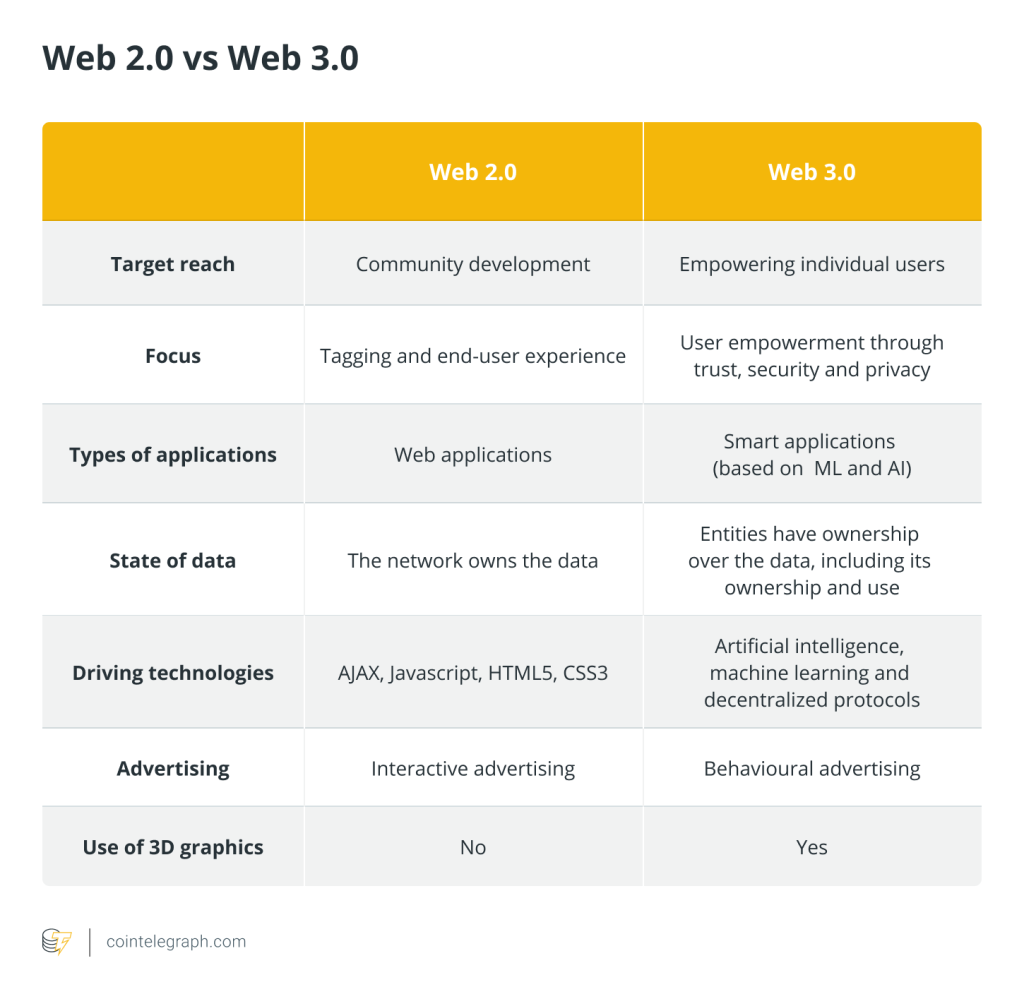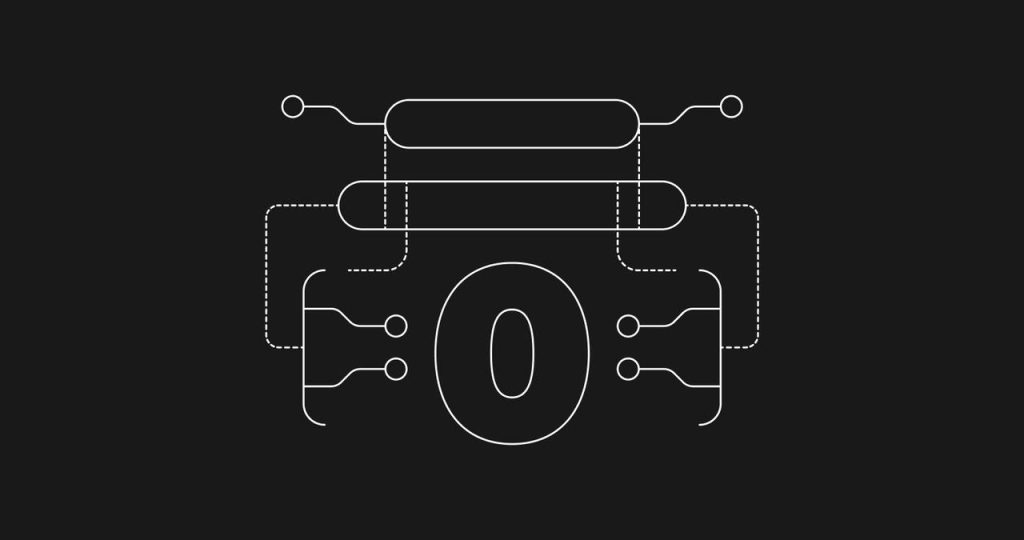What is Web 3.0: A beginner's guide to the decentralized internet of the future


Web 3.0 explained
Web 3.0 is a possible future version of the internet based on public blockchains, a record-keeping system best known for facilitating cryptocurrency transactions. The attractiveness of Web 3.0 is that it is decentralized, meaning that rather than consumers accessing the internet through services mediated by companies like Google, Apple or Facebook, individuals, themselves, own and govern sections of the internet.
Web 3.0 doesn't require “permission,” which means that central authorities don't get to decide who gets to access what services, nor does it require “trust,” meaning that an intermediary isn't necessary for virtual transactions to occur between two or more parties. Because these agencies and intermediaries are doing most of the data collection, Web 3.0 technically protects user privacy better.
Decentralized finance, often known as DeFi, is a component of Web 3.0 that's gaining steam. It entails executing real-world financial transactions on the blockchain without the help of banks or the government. Meanwhile, many major corporations and venture capital firms are pouring money into Web 3.0, and it isn't easy to conceive that their engagement won't result in some form of centralized power.
In this post, we'll go through how the web has evolved, why everyone is talking about Web 3.0, what Web 3.0 is used for, what is Web 3.0 in crypto, where it's heading next and why this matters.
The evolution of the web
The World Wide Web is the major tool used by billions of people to exchange, read and write information and communicate with others over the internet. The web has changed dramatically over the years, and its current applications are nearly unrecognizable from its early days. The web's evolution is frequently divided into three stages: Web 1.0, Web 2.0 and Web 3.0.
What is Web 1.0?
The earliest version of the internet was known as Web 1.0. Consider Web 1.0 to be the read-only or Syntactic web. Most of the participants were content consumers, while the makers were largely web developers who built websites with material delivered primarily in text or graphic format. Web 1.0 existed roughly from 1991 to 2004.
Sites delivered static material rather than dynamic, hypertext mark-up language (HTML) in Web 1.0. Data and content were supplied from a static file system rather than a database, and there was little interaction on the web pages.
What is Web 2.0?
Most of us have only seen the web in its current version, often known as Web 2.0, which is also known as the interactive read-write and social web. You don't have to be a developer to participate in the creation process in the Web 2.0 universe. Many apps are designed in such a way that anyone may become a creator.
You can create thought and share it with the rest of the world. You can also post a video and make it available to millions of others to watch, interact with and comment on in Web 2.0. Youtube, Facebook, Flickr, Instagram, Twitter and other social media are only a few examples of Web 2.0 applications.
Web technologies, such as HTML5, CSS3, and Javascript frameworks, such as ReactJs, AngularJs, VueJs, and others, enable companies to develop new ideas that allow users to contribute more to the Social Web. As a result, developers only need to design a mechanism to enable and engage users because Web 2.0 is built around them.
Consider how different prominent apps like Instagram, Twitter, LinkedIn and YouTube were in their early days compared to how they are now. All these companies go typically through the following procedure:
-
The company launches an app.
-
It enrolls as many people as possible.
-
Then it makes money off of its user base.
When a developer or corporation releases a popular app, the user experience is frequently incredibly sleek, especially as the app's popularity grows. This is why they were able to get traction so rapidly, to begin with. Many software businesses are initially unconcerned about monetization. Instead, they are solely focused on expanding and retaining new consumers, but they must eventually begin to profit.
However, the limits of taking on venture funding often harm the life cycle and, ultimately, the user experience of many of the applications we currently use. For example, when a firm raises venture capital to develop an application, its investors typically expect a return on investment in the tens or hundreds of times of what they put in. This means that, rather than pursuing a long-term growth strategy that can be sustained organically, the company is frequently pushed down one of two paths: marketing or data sales.
More data means more targeted ads for numerous Web 2.0 companies like Google, Facebook, Twitter and others. This results in more clicks and, as a result, more ad money. The exploitation and centralization of user data are fundamental to the functioning of the web as we know and use it now. As a result, data breaches are a common occurrence in Web 2.0 applications. There are even websites dedicated to keeping track of data breaches and informing you when your personal information has been hacked.
You have no control over your data or how it is stored in Web 2.0. In truth, businesses frequently track and save user data without their permission. The firms in charge of these platforms then own and manage all of this data. Furthermore, when governments believe someone is expressing an opinion that contradicts their propaganda, they frequently shut down servers or seize bank accounts. Governments can easily interfere, control or shut down applications using centralized servers.
Governments frequently intervene in banks since they are likewise digital and under centralized control. However, during periods of high volatility, excessive inflation or other political instability, they can close bank accounts or restrict access to funds. Many of these flaws will be addressed by Web 3.0, which attempts to radically rethink how we construct and interact with applications from the ground up.
What is Web 3.0?
Web 3.0, also known as Semantic Web or read-write-execute, is the era (from 2010 onwards) that alludes to the web's future. Artificial Intelligence (AI) and Machine Learning (ML) enable computers to analyze data in the same way that humans do, which aids in the intelligent generation and distribution of valuable content according to a user's specific needs.
There are a few key distinctions between Web 2.0 and Web 3.0, but decentralization is at the heart of both. Web 3.0 developers rarely create and deploy apps that run on a single server or store data in a single database (usually hosted on and managed by a single cloud provider).
Instead, Web 3.0 apps are built on blockchains, decentralized networks of numerous peer-to-peer nodes (servers), or a hybrid of the two. These programs are known as decentralized apps (DApps), and you'll hear that term a lot in the Web 3.0 community. Network participants (developers) are rewarded for delivering the highest quality services to establish a stable and secure decentralized network.

What is Web 3.0 in crypto?
When it comes to Web 3.0, you'll find that cryptocurrency is frequently mentioned. This is because many of the Web 3.0 protocols rely heavily on cryptocurrencies. Instead, it offers a monetary incentive (tokens) to anyone who wishes to help create, govern, contribute to or improve one of the projects. Web 3.0 tokens are digital assets that are associated with the vision of creating a decentralized Internet. These protocols may provide various services, such as computation, bandwidth, storage, identification, hosting and other online services formerly provided by cloud providers.
For instance, the Livepeer protocol, which is based on Ethereum, provides a marketplace for video infrastructure providers and streaming applications. Similarly, Helium incentivizes consumers and small businesses to supply and confirm wireless coverage and send device data through the network using blockchains and tokens.
People can earn a living by taking part in the protocol in various ways, both technical and non-technical. Consumers of the service typically pay to use the protocol, much like they would pay a cloud provider such as Amazon Web Services. Like many forms of decentralization, needless and frequently wasteful intermediaries are eliminated.
Furthermore, Web 3.0 will rely heavily on nonfungible tokens (NFTs), digital currencies and other blockchain entities. Reddit, for example, is attempting to make Web 3.0 inroads by devising a mechanism to employ cryptocurrency tokens to allow users to essentially control pieces of the on-site communities in which they participate. The concept is that users would use “community points,” which they would earn by posting on a specific subreddit. The user then makes points based on how many users upvote or downvote a particular post. (It's simply a blockchain version of Reddit Karma.)
Those points can essentially be used as voting shares, allowing users who have made significant contributions to have a greater say in choices that affect the community. Because those points are stored on the blockchain, their owners have more control over them; they can't be simply taken away, and they track you. To be fair, this is just one use, a corporate version of a Web 3.0 idea known as Decentralized Autonomous Organizations (DAOs), which use tokens to distribute ownership and decision-making authority more evenly.
Web 2.0 vs. Web 3.0
Let’s take a look at the table below to compare Web 2.0 and Web 3.0.

What are the properties of Web 3.0?
The move from Web 2.0 to 3.0 is happening slowly and unnoticed by the general public. Web 3.0 applications have the same look and feel as 2.0 applications, but the back-end is fundamentally different.
Web 3.0's future leads to universal applications that can be read and utilized by a wide range of devices and software kinds, making our commercial and leisure activities more convenient.
Data decentralization and the establishment of a transparent and secure environment will be enabled by the rise of technologies such as distributed ledgers and blockchain storage, which will defy Web 2.0's centralization, surveillance and exploitative advertising.
In a decentralized web, individuals will be able to rightfully control their data when decentralized infrastructure and application platforms supplant centralized tech companies.
Let's look at the four properties of Web 3.0 to better comprehend its complexities and subtleties.
Semantic web
The “semantic web” is a crucial component of Web 3.0. The phrase was coined by Tim Berners-Lee to describe a web of data that machines can analyze. So, in plain English, what does that mean? What exactly does the term “semantics” imply? What is the distinction between “I adore Bitcoin” and “I <3 Bitcoin"?
Although the syntax of the two phrases differs, the semantics of the two are similar. Semantics is concerned with the meaning or emotion expressed by facts, and both of those sentences represent the same emotions in the aforementioned example. Web 3.0's two cornerstones are the semantic web and artificial intelligence. The semantic web will aid in teaching the computer what the data means, allowing AI to develop real-world use cases that can make better use of the data.
The primary concept is to build a knowledge spiderweb throughout the internet that will aid in understanding the meaning of words and generating, sharing and connecting content through search and analysis. Web 3.0 will facilitate more data communication thanks to semantic metadata. As a result, the user experience progresses to a new level of connectivity that takes advantage of all accessible data.
3D graphics
Web 3.0 will transform the internet's future as it evolves from a simple two-dimensional web to a more realistic three-dimensional cyberworld. Web 3.0 websites and services, such as e-commerce, online games and the real estate market, make considerable use of three-dimensional design.
As strange as this thought may seem, it is true that thousands of people throughout the world are currently interacting in this place. For example, consider online games like Second Life or World of Warcraft, where participants are significantly more concerned with the well-being of their virtual avatars than their real-life counterparts.
Artificial Intelligence
Websites will be able to filter and offer the best facts to users thanks to artificial intelligence. In the current Web 2.0 era, organizations have begun to solicit customer feedback to better understand the quality of a product or asset. For example, consider a site like Rotten Tomatoes, where users may rate and review movies. Films with a higher grade are often regarded as “good movies.” Lists like these allow us to skip over the “poor data” and get straight to the “good data.”
One of the most significant contributions of Web 2.0 is peer reviews, as we've already mentioned. But, on the other hand, human recommendations are not incorruptible, as we all know. A group of people may band together to give a movie undeservedly positive reviews to raise their ratings. Artificial intelligence can learn to distinguish between good and bad data, and provide us with dependable information.
Ubiquitous
Ubiquitous refers to the concept of existing or being present in multiple places simultaneously, i.e., omnipresence. This feature is already available in Web 2.0. For example, consider social media platforms such as Instagram, where users take photos with their phones and then post and distribute them online, where they become their intellectual property. Once posted, the image becomes ubiquitous or available everywhere.
With the advancement of mobile devices and an internet connection, the Web 3.0 experience will be accessible everywhere, at any time. The internet will no longer be limited to your desktop computer, as it was with Web 1.0, or your smartphone, as it was with Web 2.0. It will be all-powerful. Because most things around you are connected online (Internet of Things), Web 3.0 might be dubbed the web of everything and everywhere.
How to get your brand ready for the Web 3.0 revolution?
Early-stage uses of the Spatial Web, or Web 3.0, are already here, as future as it sounds. Now is the time for business executives to understand what the next computer era comprises, how it will impact enterprises and how it will produce new value as it develops.
In addition, people need to be prepared to grasp how some of the more established and experimental Web 3.0 business models will accrue value in the coming years by examining existing and practical Web 3.0 business models. Some of the approaches are listed in the sections below.
Issuing a native asset
These native assets are required for the network's operation and derive their value from the security they provide; by providing a high enough incentive for honest miners to provide hashing power, the cost for malicious actors to carry out an attack rises in tandem with the price of the native asset, and the added security drives further demand for the currency, driving up its price and value. As a result, the worth of these native assets has been thoroughly examined and measured.
Building a network by holding the native asset
Some of the first crypto network companies had a single goal: to make their networks more profitable and lucrative. The business model that resulted can be summarized as “grow their native asset treasury; build the ecosystem.” Blockstream, as one of the largest Bitcoin Core maintainers, relies on its BTC balance sheet to generate value. Similarly, ConsenSys has grown to a thousand workers, constructing crucial infrastructure for the Ethereum (ETH) ecosystem to boost the worth of the ETH it owns.
Payment tokens
With the rise of the token sale, a new wave of blockchain initiatives has built their business models around payment tokens within networks, often forming two-sided marketplaces and requiring the usage of a native token for all payments. According to the assumptions, as the network's economy grows, demand for the restricted native payment token will rise, resulting in a rise in the token's value.
Burn tokens
Using a token to create communities, corporations and initiatives may not always be able to pass earnings on to token holders directly. For example, the idea of buybacks/token burns sparked a lot of interest as one of the aspects of the Binance (BNB) and MakerDAO (MKR) tokens. Native tokens are repurchased from the public market and burned as revenue flows into the project (through Binance trading fees and MakerDAO stability fees), resulting in a decrease in the supply of tokens and a price increase.
Taxation on speculation
The next generation of business models concentrated on establishing the financial infrastructure for these native assets, including exchanges, custodians and derivatives suppliers. They were all created with a single goal in mind: to provide services to users who wanted to speculate on these risky assets. Because the underlying networks are open and permissionless, organizations like Coinbase can't lock in a monopolistic position by providing “exclusive access.” Still, such companies' liquidity and brands provide defensible moats over time.
What are the advantages of Web 3.0 over its predecessors?
Because intermediaries are no longer involved in Web 3.0, user data will no longer be controlled. This minimizes the likelihood of government or corporate censorship, as well as the effectiveness of denial-of-service (DoS) attacks.
More extensive datasets supply algorithms with more information to evaluate as more products become connected to the internet. This will allow them to deliver more accurate information that is tailored to the individual user's demands.
Before Web 3.0, finding the most refined result on search engines was a difficult task. They have, however, improved their ability to discover semantically relevant results based on search context and information over time. As a result, web browsing becomes more convenient, allowing everyone to get the specific information they require with relative ease.
Customer service is critical for a positive user experience on websites and web applications. However, many successful web firms are unable to scale their customer support operations due to the high expenses. Users can have a better experience engaging with support personnel by using intelligent chatbots that can talk to several consumers simultaneously, which is possible due to Web 3.0.






… [Trackback]
[…] Information on that Topic: x.superex.com/academys/beginner/2276/ […]
… [Trackback]
[…] Here you will find 32283 additional Information on that Topic: x.superex.com/academys/beginner/2276/ […]
… [Trackback]
[…] Info on that Topic: x.superex.com/academys/beginner/2276/ […]
… [Trackback]
[…] Read More Information here on that Topic: x.superex.com/academys/beginner/2276/ […]
… [Trackback]
[…] Read More to that Topic: x.superex.com/academys/beginner/2276/ […]
… [Trackback]
[…] Find More on to that Topic: x.superex.com/academys/beginner/2276/ […]
… [Trackback]
[…] Info to that Topic: x.superex.com/academys/beginner/2276/ […]
… [Trackback]
[…] Find More to that Topic: x.superex.com/academys/beginner/2276/ […]
… [Trackback]
[…] Info on that Topic: x.superex.com/academys/beginner/2276/ […]
… [Trackback]
[…] There you will find 36460 more Info to that Topic: x.superex.com/academys/beginner/2276/ […]
… [Trackback]
[…] Find More Info here on that Topic: x.superex.com/academys/beginner/2276/ […]
… [Trackback]
[…] Information to that Topic: x.superex.com/academys/beginner/2276/ […]
… [Trackback]
[…] There you will find 27913 additional Information on that Topic: x.superex.com/academys/beginner/2276/ […]
… [Trackback]
[…] There you can find 38415 more Info on that Topic: x.superex.com/academys/beginner/2276/ […]
… [Trackback]
[…] There you will find 96647 additional Information on that Topic: x.superex.com/academys/beginner/2276/ […]
… [Trackback]
[…] Find More here to that Topic: x.superex.com/academys/beginner/2276/ […]
… [Trackback]
[…] Here you can find 41877 additional Info on that Topic: x.superex.com/academys/beginner/2276/ […]